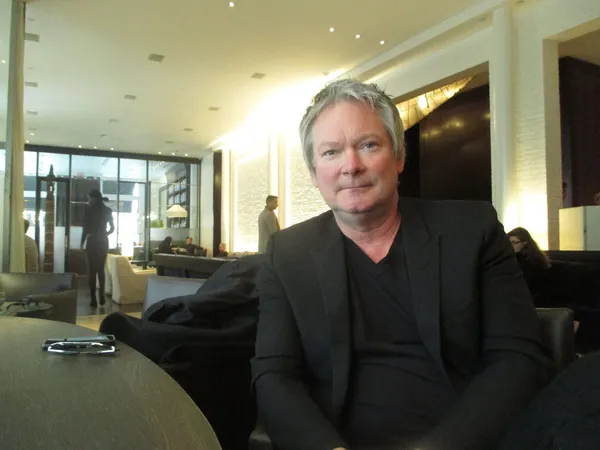 |
| James Crump on Antonio Lopez: "Helmut Newton, Guy Bourdin, Chris von Wangenheim, you know, Avedon, Penn - he's working at the same level, yet he is an illustrator." Photo: Anne-Katrin Titze |
Another highlight of this year's DOC NYC is James Crump's Antonio Lopez 1970: Sex Fashion & Disco screening in the Metropolis competition. The film on the famed fashion illustrator features Jessica Lange, Grace Jones, Jerry Hall, Bill Cunningham, Yves Saint Laurent, Donna Jordan, Pat Cleveland, Jane Forth, Corey Tippin, Grace Coddington, Patti D’Arbanville, Karl Lagerfeld, Joan Juliet Buck, Bob Colacello, Paul Caranicas, Juan Ramos, Tina and Michael Chow with film clips including Bertrand Bonello's Saint Laurent, Pierre Thoretton's L'Amour Fou, and Andy Warhol's L'Amour.
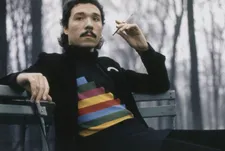 |
| Antonio Lopez: "He was embracing this idea of diversity and inclusivity in the mid-Sixties when today people are taking credit for the diversity of the runway." |
James Crump (director of Troublemakers: The Story of Land Art and Black White + Gray: A Portrait Of Sam Wagstaff And Robert Mapplethorpe) and I met at the Mercer Hotel in SoHo for a conversation on his latest documentary which had its world premiere last month in the London Film Festival.
In Antonio Lopez 1970: Sex Fashion & Disco, we see the master illustrator breathe in his inspiration and exhale it onto the paper in front of him. Crump's tumultuously entertaining journey through the fashion world of the late Sixties, early Seventies lets us discover a man far too few know about.
"Magical", "cat-like", "irresistible", "so sexy", "extremely seductive", "wide-open and free as a bird" and "an incredible flirt" - this is how Antonio Lopez is described. Folks were "mesmerised" by his "magnetism", had a "wild crush on him" or were "absolutely crazy about him".
Bill Cunningham, who found Lopez and his art director and creative partner, Juan Ramos, an apartment in Carnegie Hall (they became his neighbors and neighbors of Norman Mailer there) talks about their close friendship. We learn from supermodel Pat Cleveland what he was like at Parsons in 1968 and what went on around the Bethesda Fountain in Central Park.
 |
| Karl Lagerfeld with Antonio Lopez: "Karl's career had already started in the late Fifties. He was essentially looking for the next thing." |
We get a reminder about the no-eyebrow look and hear about the competing tables at Max's Kansas City, where Antonio, Juan, and their muses rivaled Andy Warhol's table in coolness and flair. As the images unfold, we marvel at the diversity, the fun, the celebratory mood. When the gang moved from New York to Paris, they continued the feast with Karl Lagerfeld. The difference between the cities, you ask? "The French give dinner parties against someone." The fun doesn't seem to end - until it does.
Anne-Katrin Titze: Let's talk about the clans before we get to Karl Lagerfeld. It's interesting how you show the dynamics. The clans. The first clan is at Max's Kansas City and the competing sections - the "cool corner" around Antonio and then the Warhol one. The non-cool corner?
James Crump: I wouldn't say it's not cool. I would just say …
AKT: It is a funny moment in the film.
JC: Thinking about Karl Lagerfeld and thinking about Andy as well is that Karl is about ten years older than Antonio and Juan [Ramos]. When they meet he's like around 37 years old, Antonio and Juan are in their late twenties. Karl's career had already started in the late Fifties. He was essentially looking for the next thing. He recognised talent, the potential for collaboration. And he, in many ways, I think, appropriated those aesthetics, that street essence, that street style.
_225.webp) |
| Patti D'Arbanville by Antonio Lopez: "He is an illustrator working at a time when illustration is completely on the wane and photography is superseding it." |
AKT: At Chloé at the time?
JC: At Chloé, yeah. The kind of gestures that were coming out of the work of Antonio and Juan and their entourage. They hung out with those American street kids that came to Paris. It reenergised Karl at a time when he needed the next thing to keep going. It's like food.
AKT: Did you reach out to him?
JC: I did. I met Karl a few times. Over the years he was very supportive of my work. I actually invited him to participate in this film. I actually delivered a hand-written letter to his assistant. But he chose not to. He didn't feel like at this moment in his life it was something that he wanted to do.
AKT: Has he seen your film? The ending is quite strong.
JC: It hasn't been released yet. It's only been in the London Film Festival, it's playing in DOC NYC, then in Amsterdam [IDFA]. Then when we'll release it theatrically in Paris eventually, I'm sure he'll see it at some point. I mean, I hope that he will. I think the story that comes out in the end … I think Karl is beautifully represented in the movie. He's shown in such a youthful way, in such an intelligent, ambitious, generous and friendly way and that moment at the end of Antonio and Juan's life is something that happens. I think it was a tough time.
When AIDS appeared and becomes that kind of plague and gets named, people were trying to get their heads around it and were trying to understand what's happening. It decimates so many people so quickly. So it was a very tough, difficult, tragic time. This story is a part of it. I didn't tell that story. It was Bill Cunningham. But as the whole film goes, I think he [Lagerfeld] comes off beautifully.
AKT: You show him acting in Warhol's film L'Amour! That's something people might not be aware of.
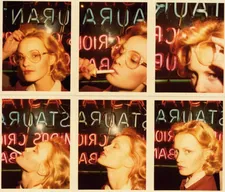 |
| Jessica Lange by Antonio Lopez: "He had his finger on the pulse of music, on fine arts, on popular culture ..." |
JC: That's a very obscure film. The only film that Warhol did that dealt with fashion. It's not in general release, you can't find that movie, it's not available to stream. In my research, that's one of the first things I licensed because I found L'Amour truly was a pastiche of the entourage of Antonio and Juan. It was almost like reality television. The characters are the same characters that are in Antonio's camp.
AKT: Your film also makes the point of distinguishing the Lagerfeld camp and the Yves Saint Laurent camp. Someone says that for Saint Laurent it was almost like family whereas for Lagerfeld, the only child and heir to the condensed milk fortune …
JC: For Karl, as it is pointed out in the film, he is protean, he's ever-changing. He is someone who keeps moving through cycles and cycles and cycles. As Joan Buck says, he goes through many best friends. It's described by Bob Colacello [former editor-in-chief of Andy Warhol’s Interview magazine] as being this very modern man who is always changing.
But Joan Buck actually says Yves Saint Laurent's wasn't really a family, it was a phalanx. It was just people there to support him, to hold him up. I think that's probably more accurate.
AKT: You have a few clips I saw at the end credits from L'Amour Fou, the documentary.
JC: We have some historical clips that came out of there.
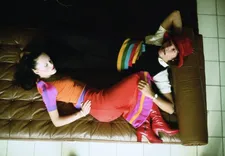 |
| Antonio Lopez with Warhol Superstar and Factory regular Jane Forth |
AKT: And from Bertrand Bonello's film as well?
JC: Right. We wanted to create what I call synthetic footage. It's like a total montage of the Club 7. Because I only found one clip of Club 7. So I had to create this feeling, this montage using all kinds of elements - footage from documentaries, from other films and lots of stills and mix that with this very very brief clip of the Club 7. It's interesting. You're the first person who has asked me about that.
AKT: You're very successful in mixing it. That's why I asked, because I didn't recognise anything from these other films. The diversity Antonio celebrated in fashion is still stunning to see. You have a quote in the film: "He was always looking for people a little bit flawed." Which is perfect.
JC: I think he was looking for imperfect beauty. He's not interested in the pristine, the classical. For instance, you look at supermodels and people talk about symmetry of their faces. That's not something that Antonio would have been wound up on. He was interested in the personality, someone that had internal drama.
Also about Antonio, say the mid-Sixties versus today, he was so prescient injecting race and ethnicity into fashion. He was embracing this idea of diversity and inclusivity in the mid-Sixties when today people are taking credit for the diversity of the runway.
 |
| Corey Tippin, Donna Jordan, Jane Forth, Jay Johnson: "I think he was looking for imperfect beauty. He's not interested in the pristine, the classical." |
You know, 2017, the year of the trans model. And what's interesting about Antonio and Juan, they were advocating for these things as early as the mid-Sixties. As it's pointed out, they wanted to draw black girls, Puerto Rican girls, they wanted to draw girls from New York City who weren't the typical standard beauty. He was looking for something else that was inside of them.
AKT: Especially that point about the flaw makes sense. Lacan says the object-cause of desire is the imperfection. That's what we're drawn to. It is the thing that you think disturbs you. It isn't. Take that away and the desire is gone.
JC: That's really a great analogy. That Lacanian analogy, it's fantastic. I never thought of it that way but you're absolutely right.
AKT: Donna [Jordan, seen in Andy Warhol’s L’Amour] has that little gap between her front teeth.
JC: There's this look that's coming back that harkens back to that period of the late Sixties, early Seventies. I'm thinking of, like Georgia May Jagger. She has this similar kind of gap and those big Mick Jagger lips. Not a perfect specimen beauty as per the symmetry and the classic look, you know, the Cheryl Tiegs. She's something else, there's something more exotic about her.
You're starting to see some of that spirit of that time, that sensuality. It's about individualism. You're seeing it in recent collections, Jeremy Scott, for instance, the American designer who designs for Moschino. If you look at his last few years of collections, there's incredible affinities to some of the things that were happening in the Seventies.
AKT: Antonio's medium was illustrations.
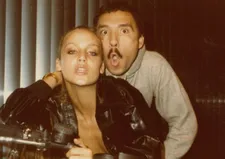 |
| Antonio Lopez with Jerry Hall: "He was interested in the personality, someone that had internal drama." |
JC: He is an illustrator working at a time when illustration is completely on the wane and photography is superseding it. He's working at the same level as some of the great photographers that I love that are around at that moment. Helmut Newton, Guy Bourdin, Chris von Wangenheim, you know, Avedon, Penn - he's working at the same level, yet he is an illustrator. It's a 19th century thing.
AKT: Grace Coddington [former Creative Director for US Vogue] says how much she learned from him. She is one of the greatest stylists herself.
JC: She calls him a stylist. Which is really interesting to think of Antonio as an arbiter of style. He had his finger on the pulse of music, on fine arts, on popular culture, on the street, essentially on the street. I love how she says how influential he was to her because of all the things he could bring together into a look. We have that great footage in the film of Antonio styling. It's very rare footage.
AKT: Jessica Lange also mentions how he dressed her up before going out. By complete coincidence, I saw a film over the weekend that I had wanted to see for the longest time - Urban Cowboy. And there is Jerry Hall having a cameo with her sister. In the structure of your film, I like how we have to wait before certain people show up. Karl Lagerfeld, or Jerry Hall, for example.
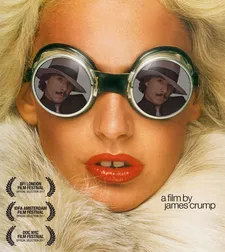 |
| Antonio Lopez 1970: Sex Fashion & Disco poster |
JC: It's challenging. It's like cinematic tension. You can't give it all away at once. In my films, especially in this one, the storytelling is not linear. There's this incestuous quality about the cast. How you have for instance, Grace Coddington married to Michael Chow who meets Tina Chow. The Jerry Hall connection, there's something very incestuous about it.
I was trying to weave a story together where the transitions, they make sense because it's connected through relationships. We worked very hard on the editing. Probably the most challenging part of the film was editing for a year. Taking 200 hours of material and reducing it to 90 minutes. That's the fun part but also the maddening part of filmmaking.
Coming up - James Crump on Bill Cunningham's relationship to the world of Antonio Lopez, Luca Guadagnino's Call Me By Your Name, Francis Bacon and the "void of the mouth", Paul Thomas Anderson, Charles James and Sputnik.
DOC NYC public screening of Antonio Lopez 1970: Sex Fashion & Disco - Friday, November 10 at 9:30pm - SVA Theatre; Expected to attend: James Crump, Corey Tippin, Pat Cleveland, Donna Jordan, and producer Ronnie Sassoon
The eighth annual DOC NYC runs from November 9 through November 16.
























